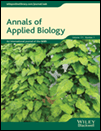Ver ítem
- xmlui.general.dspace_homeCentros Regionales y EEAsCentro Regional Buenos Aires SurEEA BalcarceArtículos científicosxmlui.ArtifactBrowser.ItemViewer.trail
- Inicio
- Centros Regionales y EEAs
- Centro Regional Buenos Aires Sur
- EEA Balcarce
- Artículos científicos
- Ver ítem
Low temperature differentially affects tillering in spring and winter wheat in association with changes in plant carbon status
Resumen
The higher tillering potential of winter wheat cultivars as compared to spring ones has been attributed to an earlier tillering onset in the former. Tillering in grasses is known to depend on temperature and light environment, and may be mediated by plant C status. The aim of this work was to elucidate whether differences in carbohydrate accumulation between wheat types at low temperature may contribute to differences in tillering potential. A set of
[ver mas...]
The higher tillering potential of winter wheat cultivars as compared to spring ones has been attributed to an earlier tillering onset in the former. Tillering in grasses is known to depend on temperature and light environment, and may be mediated by plant C status. The aim of this work was to elucidate whether differences in carbohydrate accumulation between wheat types at low temperature may contribute to differences in tillering potential. A set of experiments with contrasting temperatures was conducted in both field enclosures (high irradiance, three experiments) and growth chambers (low irradiance, two experiments). The relative tiller production rate (RTR) was the highest in winter cultivars grown in cool field enclosures, and the lowest in spring cultivars in growth chambers, either cool or warm. Plant C status was inversely related to temperature the response being more pronounced in winter cultivars. Components of RTR, site filling and phyllochron, responded differently to environment and plant C status. Phyllochron increased with temperature, and was inversely correlated to sugar concentration irrespective of cultivar type. Site filling increased with irradiance in both cultivar types while sugar concentration contributed additively to its promotion solely in winter cultivars. Nevertheless, variation in site filling was larger in percentage than variation in phyllochron (200% and 41%, respectively, between most contrasting treatments). Thus, differences in tillering potential between winter and spring wheats may be attributed not only to the earlier tillering onset in the former but also to their differential response to environment and C status.
[Cerrar]

Autor
Lorenzo, Maximo;
Assuero, Silvia Graciela;
Tognetti, Jorge Alberto;
Fuente
Annals of Applied Biology 166 (2) : 236-248 (March 2015)
Fecha
2015-03
Editorial
Wiley
ISSN
0003-4746
1744-7348
1744-7348
Formato
pdf
Tipo de documento
artículo
Palabras Claves
Derechos de acceso
Restringido
 Excepto donde se diga explicitamente, este item se publica bajo la siguiente descripción: Creative Commons Attribution-NonCommercial-ShareAlike 2.5 Unported (CC BY-NC-SA 2.5)
Excepto donde se diga explicitamente, este item se publica bajo la siguiente descripción: Creative Commons Attribution-NonCommercial-ShareAlike 2.5 Unported (CC BY-NC-SA 2.5)

